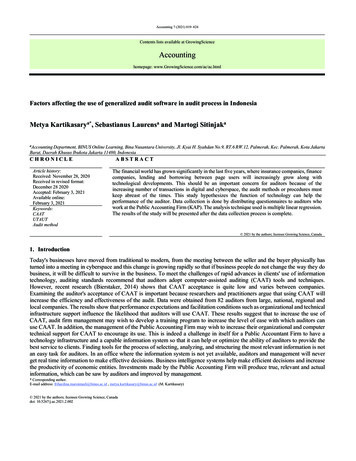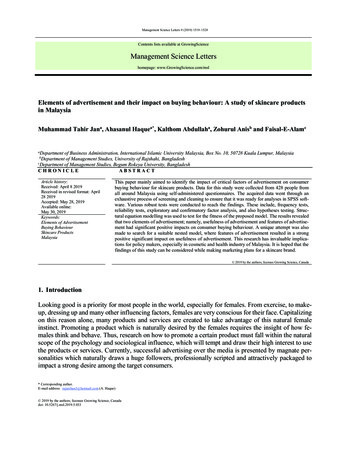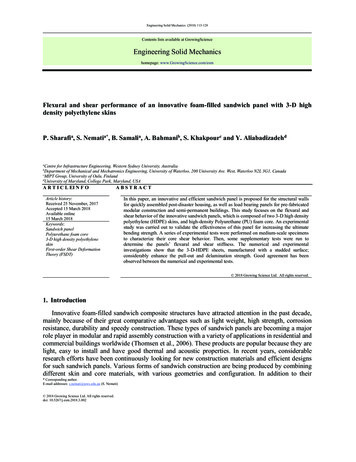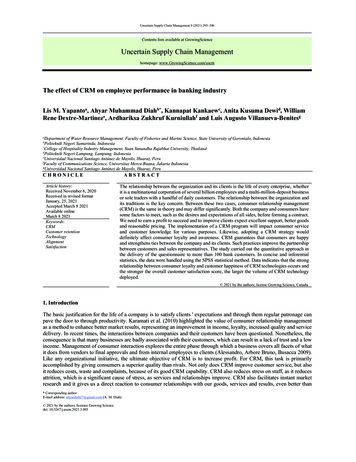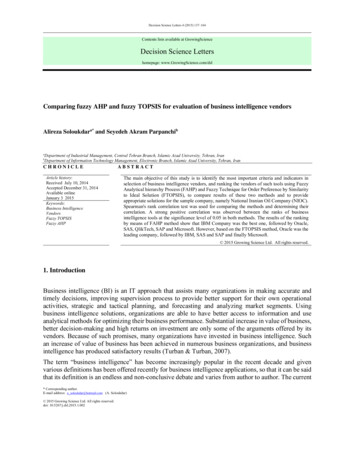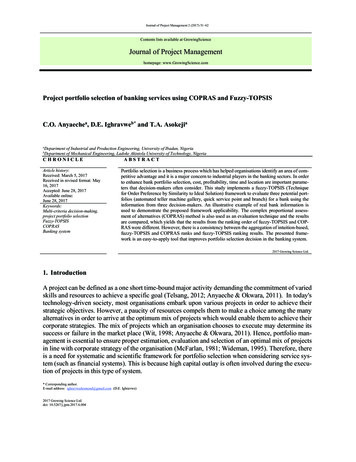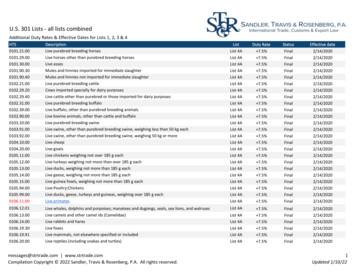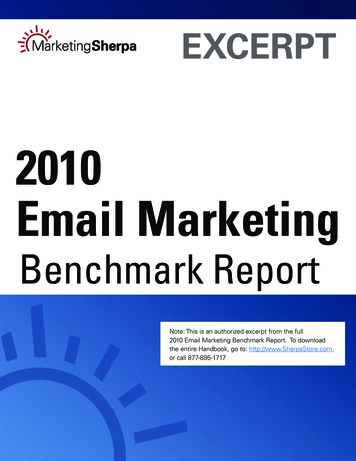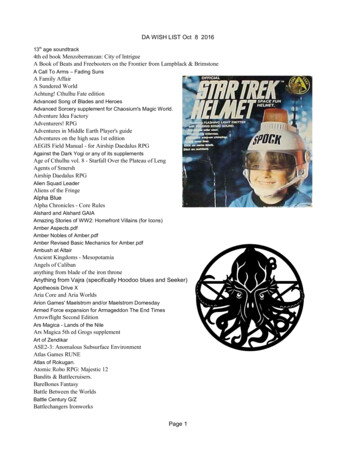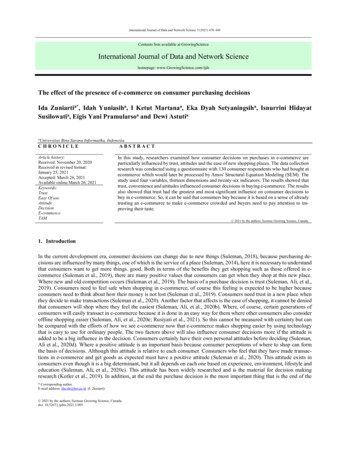
Transcription
International Journal of Data and Network Science 5 (2021) 479–484Contents lists available at GrowingScienceInternational Journal of Data and Network Sciencehomepage: www.GrowingScience.com/ijdsThe effect of the presence of e-commerce on consumer purchasing decisionsIda Zuniartia*, Idah Yuniasiha, I Ketut Martanaa, Eka Dyah Setyaningsiha, Isnurrini HidayatSusilowatia, Eigis Yani Pramularsoa and Dewi AstutiaaUniversitas Bina Sarana Informatika, IndonesiaCHRONICLEArticle history:Received: November 20, 2020Received in revised format:January 25, 2021Accepted: March 26, 2021Available online:March 26, 2021Keywords:TrustEasy Of useAttitudeDecisionE-commerceTAMABSTRACTIn this study, researchers examined how consumer decisions on purchases in e-commerce areparticularly influenced by trust, attitudes and the ease of new shopping places. The data collectionresearch was conducted using a questionnaire with 130 consumer respondents who had bought atecommerce which would later be processed by Amos' Structural Equation Modeling (SEM). Thestudy used four variables, thirteen dimensions and twenty-six indicators. The results showed thattrust, convenience and attitudes influenced consumer decisions in buying e-commerce. The resultsalso showed that trust had the greatest and most significant influence on consumer decisions tobuy in e-commerce. So, it can be said that consumers buy because it is based on a sense of alreadytrusting an e-commerce to make e-commerce crowded and buyers need to pay attention to improving their taste. 2021 by the authors; licensee Growing Science, Canada.1. IntroductionIn the current development era, consumer decisions can change due to new things (Suleman, 2018), because purchasing decisions are influenced by many things, one of which is the service of a place (Suleman, 2014), here it is necessary to understandthat consumers want to get more things. good. Both in terms of the benefits they get shopping such as those offered in ecommerce (Suleman et al., 2019), there are many positive values that consumers can get when they shop at this new place.Where new and old competition occurs (Suleman et al., 2019). The basis of a purchase decision is trust (Suleman, Ali, et al.,2019). Consumers need to feel safe when shopping in e-commerce, of course this feeling is expected to be higher becauseconsumers need to think about how their money is not lost (Suleman et al., 2019). Consumers need trust in a new place whenthey decide to make transactions (Suleman et al., 2020). Another factor that affects is the ease of shopping, it cannot be deniedthat consumers will shop where they feel the easiest (Suleman, Ali, et al., 2020b). Where, of course, certain generations ofconsumers will easily transact in e-commerce because it is done in an easy way for them where other consumers also consideroffline shopping easier (Suleman, Ali, et al., 2020e; Rusiyati et al., 2021). So this cannot be measured with certainty but canbe compared with the efforts of how we see e-commerce now that e-commerce makes shopping easier by using technologythat is easy to use for ordinary people. The two factors above will also influence consumer decisions more if the attitude isadded to be a big influence in the decision. Consumers certainly have their own personal attitudes before deciding (Suleman,Ali et al., 2020d). Where a positive attitude is an important basis because consumer perceptions of where to shop can formthe basis of decisions. Although this attitude is relative to each consumer. Consumers who feel that they have made transactions in e-commerce and get goods as expected must have a positive attitude (Suleman et al., 2020). This attitude exists inconsumers even though it is a big determinant, but it all depends on each one based on experience, environment, lifestyle andeducation (Suleman, Ali, et al., 2020c). This attitude has been widely researched and is the material for decision makingresearch (Kotler et al., 2019). In addition, at the end the purchase decision is the most important thing that is the end of the* Corresponding author.E-mail address: ida.idz@bsi.ac.id (I. Zuniarti) 2021 by the authors; licensee Growing Science, Canada.doi: 10.5267/j.ijdns.2021.3.005
480consumer process that they have gone through from a series of purchasing processes (Kotler & Amstrong, 2016). After variousstimuli have been carried out, consumers will choose to shop in e-commerce according to their final choice (Suleman, Ali, etal., 2020a). So that this research will answer how consumer decisions actually occur.2. Theoretical framework and hypotheses developmentThe purpose of this research is to describe the direct relationship between easy-of-use trust and attitudes toward consumerdecisions. The following is an explanation used in this study to build the following hypothesis.2.1 TrustTrust is important and is a proven factor influencing the decision to shop based on several previous studies which state this inthe results of their research, among others (Hsu et al., 2014; Al-Debei et al., 2015; Zeba & Ganguli, 2016; Marriott & Williams,2018; Suleman et al., 2019). For this reason, the role of trust makes e-commerce a place to shop or not so that this can be thebasis for determining and hypothesizing. Therefore, the researchers made the first hypothesis in this study as follows:H1: Trust has a significant effect on the purchasing decision.2.2 Easy Of UseEvery time you make a purchase, of course what you will choose is an e-commerce, which in the process is easy in the sensethat new consumers can process transactions from ordering goods to payment processing and the ease of monitoring thetransaction process, therefore the easier it is to understand and learn, it will make consumers choose to buy in an e-commerceand there are also many studies that state that this convenience is an influence on decisions, including research results, and(Alwafi & Magnadi, 2016; Wahyuningtyas & Widiastuti, 2017; Zolait et al., 2018; Shabrina & Zaki, 2019; Cho & Son, 2019).Sourced from the basis of this research, this convenience can be made a hypothesis in this study so that the researcher makesthe second hypothesis in this study as follows:H2: Easy of Use has a significant effect on the purchasing decision.2.3 AttitudeConsumers in themselves have attitudes based on previous beliefs and experiences in e-commerce, therefore an e-commercethat is their choice must have a positive value in consumers. The effect of attitudes on this decision has been widely researchedand the results show that attitudes have an effect on consumer decisions in these studies, among others, (Tingchi Liu et al.,2012; Adnan, 2014; Wu & Ke, 2015; Lee, 2016; Indarsin & Ali, 2017; Suleman et al., 2020a). Therefore, the researcher madethe third hypothesis in this study as follows:H3: Attitude has a significant effect on the purchasing decision.From the explanation of the hypothesis above, an image of the framework of thought in this study can be made as follows canbe seen in Fig. 1 below:Trust (X1)H1Ease of Use(X2)H2Attitude(X3)H3Fig. 1. Research FrameworkDecision toShop (Y)
I. Zuniarti et al. / International Journal of Data and Network Science 5 (2021)4813. Research methods3.1 Population and SampleThe population in this study is large and the number is not known with certainty. Therefore, the determination of the sampleusing a 5 calculation of the number of indicators as many as 130 respondents (Ferdinand, 2018). The sampling techniqueused in this study was quota sampling where the sample was. In this study using 4 variables, 13 dimensions and 26 indicators.Where each indicator becomes a statement that is asked of the respondent who is given 26 questions to be answered and theresults will be tabulated. All questions used in this research have previously been tested so that the instruments are valid andreliable. where the results of the respondents' answers are then tabulated and processed using SEM AMOS 23.3.2 Data analysis and results measurement itemsThis study uses three dimensions with six indicators for trust variables which have been adapted from research (Indarsin &Ali, 2017) which has been adjusted. As for the ease of use variable, it uses three dimensions with six indicators taken fromresearch (Suleman, Zuniarti, & Sabil, 2019). Furthermore, consumer attitude variables use three dimensions and six indicatorsadapted from research (Suleman, Ali, et al., 2020a) and finally for purchasing decision variables using four dimensions witheight indicators obtained from adjusted theory (Philip & Keller, 2016). All 26 indicators were measured using a scale of 1“Strongly Disagree” to 5 “Strongly Agree”.3.3 SEM AMOS AnalysisGoodness Of Fit (GOF) AnalysisThe results of the first AMOS SEM test which aims to determine whether the overall compatibility model will be comparedbetween the data entered and the standards owned by Amos. And the output of SEM AMOS results the data output on theoverall compatibility test can be seen in Table 1 below:Table 1The results of the goodness of fit (GOF)MeasureGOFAbsolute fit ModelGoodness of fit Index (GFI)Root Mean Square Error (RMSEA)Incremental Fit ModelComparative Fit Index (CFI)Normal Fit Index (NFI)Incremental Fit Index ( IFI)Relative fit Index (RFI)Parsimonious Fit ModelParsimonious normed fit index (PNFI)MeasurementGood FitMarginal FitMeasurementResult 0.90 0.080.80 - 0.900.900.041Good FitGood Fit 0.90 0.90 0.90 0.900.80 - 0.900.80 - 0.900.80 - 0.900.80 - 0.900.930.810.920.83Good FitMarginal FitGood FitMarginal Fit 0.900.80 - 0.900.86Marginal FitResults of Overall Model Processing (GOF) If seen in Table 1 which is the SEM output from AMOS, the absolute fit sizedata model is found which aims to determine the level of prediction of all models (structural and measurement models) todata suitability consisting of RMSEA 0.041 0, 08 (model fit) and a GFI value of 0.90. It can be concluded that all the modelstested are close to the absolute fit model testing criteria at a fairly good level of testing criteria. And for other model fit criteria,the Incremental Fit Model consists of several conformity test instruments, namely the value of CFI 0.93; NFI 0.81; IFI 0.92 and RFI 0.83, the results state that the structural equation model is said to be good because it is at a fairly good levelof testing criteria and has met the requirements of the Incremental Fit Model. On the fit size, the stingy fit model can be seenin the PNFI results 0.86; From these outputs it can be concluded that the model is said to be at the level of testing criteria isquite good and meets the requirements of the parsimonious fit model.3.4 Measurement ModelThe second output result in SEM AMOS shows the following data results. According to (Ferdinand, 2018) the compositereliability of a measurement model is said to be good reliability to measure each latent variable if the construct reliabilityvalue (CR) is 0.7 or more than the value of extracted variance (VE) is greater than 0.05, states that in exploration reliabilityresearch between 0.5 - 0.6 can be accepted and then at SEM AMOS a one-way test is carried out with a 95% confidence level,the commonly used critical value (CR) 1.96 which means the assumption of normality is rejected at significance level (P) 0.05 (5%).
482Table 2Construct reliability and variance extractedConstructsTrustEase Of 0From Table 2 data it is found that all 26 indicators are valid and reliable because (CR) is 0.7 or more than the value ofextracted variance (VE) is greater than 0.053.5 Match analysis of structural models or hypothesis testingThe next step is to look at the structural model or hypothesis test in this case it can be seen about how the conclusions of thehypothesis in this study can be seen in Table 3 below:Table 3Hypotheses test resultsNoHypotheses1H1Trust Decision2H2Easy Of Use Decision3H3Attitude nSupportedSupportedSupportedIn the hypothesis test results in Table 3, which is the result of SEM AMOS output data processing which shows that the fiveare accepted, meaning that (H1-H3) all show an effect and are significant. The basis for decision making is influential andsignificant based on the value of the t-value T-table 1.96 and α 0.05, where the magnitude of the effect can be seen in theresulting SLF value which shows how much influence the independent variable has on the dependent. The test results showthat trust (H1) has a positive and significant effect on decision with an output value of 8.0 greater than the table 1.96 and astandardized coefficient of 0.68. Then (H2) ease of use towards decision, the t-value is 2.2 which is also greater than the ttable (1.96) with a standard coefficient of 0.28. Whereas for (H3) attitude towards the decision found the values of 5.2 whichare also greater than the table (1.96) with a coefficient of 0.56.4. Discussions and conclusionAfter seeing the results of research that has been conducted by researchers, the researchers conclude. Where the basis for thisconclusion is obtained from the results obtained, among others, it shows that trust has an effect and is significant on decisions,ease of use has an effect and is significant on decisions and finally that consumer attitudes have a significant and significanteffect on consumer decisions. And the results found that the factor that has the greatest influence and significance on consumerdecisions is consumer trust in e-commerce. The results of the first study found that trust has a significant effect on consumerdecisions, this reinforces previous studies which have many of the same results. In determining the factors that need to bemade positive, the main thing is consumer trust, therefore entrepreneurs or e-commerce owners must strive to increase consumer confidence in e-commerce, in this case the part that needs to be improved is the sense of transaction security in payments
I. Zuniarti et al. / International Journal of Data and Network Science 5 (2021)483made. for it is at the heart of all the indecisiveness that the consumer thinks. when an e-commerce can convince a sense oftrust for transactions, the consumer's decision to buy is not a difficult thing to materialize.The results of the second study found in this study were that ease of use had a significant and significant effect on consumerdecisions, this is also something that has naturally happened and has been widely discussed in previous studies. Becauseindeed the name ease of use will be a determining factor once again even though people already believe, but if it is difficultto make transactions or the process is confusing, consumers will still choose other e-commerce that is easier in the process ofusing it. E-commerce uses a new system which must be made easy and immediately understood by even new users.The results of the third study indicate that attitudes have an effect and are significant on consumer decisions. These resultsalso reinforce previous research which showed the same results. Here it is necessary to understand by e-commerce ownersthat indeed today's consumers have different characters, they have different backgrounds and are born in different generationswhich of course have an effect on negative and positive attitudes towards e-commerce, therefore for certain generations it iscertain have a positive attitude supported by trust and ease of use of e-commerce, therefore efforts that can be done are toshow a sense of help in every transaction process that consumers go through and this can change consumer attitudes towardse-commerce.5. LimitationIn this study of course there are still many shortcomings and limitations, among others, the researchers' suggestions for futureresearchers, especially on the number of variables that affect consumer decisions where other variables can be added such asenjoyment and risks that affect decisions such as in research (Suleman et al., 2019)ReferencesRusiyati, S., Suleman, D., Riftiasari, D., Suharyadi, D., Marwansyah, S., & Sabil, S. (2021). How Enjoyment, Trust inIntention when choosing a shopping place. Dinasti International Journa of Management Science, 2(4), 551–560.Adnan, H. (2014). An Analysis of the Factors Affecting Online Purchasing Behavior of Pakistani Consumers. InternationalJournal of Marketing Studies, 6(5), 133-148. https://doi.org/10.5539/ijms.v6n5p133Al-Debei, M. M., Akroush, M. N., & Mohamed Ibrahiem Ashouri. (2015). Consumer attitudes towards online shopping: Theeffects of trust, perceived benefits, and perceived web quality. Internet Research, 25(5), 707-733.Alwafi, F., & Magnadi, R. H. (2016). Pengaruh Persepsi Keamanan, Kemudahan Bertransaksi, Kepercayaan Terhadap TokoDan Pengalaman Berbelanja Terhadap Minat Beli Secara Online Pada Situs Jual Beli Tokopedia.Com. Journal ofManagement, 5(2), 1–15.Cho, E., & Son, J. (2019). The effect of social connectedness on consumer adoption of social commerce in apparel shopping.Fashion and Textiles, 6(1), Pp. 1-17. , A. (2018). Metode penelitian manajemen. Universitas Diponegoro.Hsu, M. H., Chuang, L. W., & Hsu, C. S. (2014). Understanding online shopping intention: The roles of four types of trustand their antecedents. Internet Research, 24(3), 332–352. https://doi.org/10.1108/IntR-01-2013-0007Indarsin, T., & Ali, H. (2017). Attitude toward Using m-Commerce: The Analysis of Perceived Usefulness Perceived Ease ofUse, and Perceived Trust: Case Study in Ikens Wholesale Trade, Jakarta – Indonesia. Saudi Journal of Business andManagement Studies, 2,(11), 995-1007. https://doi.org/10.21276/sjbms.2017.2.11.7Kotler, P., & Amstrong, G. (2016). Prinsip-prinsip Pemasaran. Edisi13. Jilid 1. Erlangga.Kotler, P., Kartajaya, H., & Setiawan, I. (2019). Marketing 4.0: Moving From Traditional To Digital. In Gramedia. PT.Gramedia Pustaka Utama. https://doi.org/10.1142/9789813275478 0004Lee, H. S. (2016). Examining neighborhood influences on leisure-time walking in older Korean adults using an urbplan.2015.12.011Marriott, H. R., & Williams, M. D. (2018). Exploring consumers perceived risk and trust for mobile shopping: A theoreticalframework and empirical study. Journal of Retailing and Consumer Services, 42, 8.01.017Philip, K., & Keller, K. L. (2016). Marketing Management 16 edition. Pearson Prentice Hall.Rusiyati, S., Suleman, D., Riftiasari, D., Suharyadi, D., Marwansyah, S., & Sabil, S. (2021). How Enjoyment, Trust inIntention when choosing a shopping place. Dinasti International Journal of Management Science, 2(4), 551–560Shabrina, R., & Zaki, B. (2019). The Influence of Perceived Usefulness, Ease of Use, Attitude, Self-efficacy, and SubjectiveNorms Toward Intention to Use Online Shopping. International Business and Accounting Research Journal, 3(1), 1–14.https://doi.org/DOI: http://dx.doi.org/10.15294/ibarj.v3i1Suleman, D. (2014). PENGARUH KUALITAS PELAYANAN TERHADAP KEPUASAN KONSUMEN PADARESTAURANT MY BENTO. Perspektif, 12(2). https://doi.org/DOI: https://doi.org/10.31294/jp.v12i2.1143Suleman, D. (2018). Faktor Penentu Keputusan Konsumen Indonesia MemilihTempat Belanja Disebuah E-Commerce(Theory of Planned Behavior). Jurnal JDM, I(02), 1–9. cle/view/4120Suleman, D., Ali, H., Nusraningrum, D., & Ali, M. M. A. (2019). Perceived Ease of Use, Trust and Risk toward Attitude and
484Intention in Shopping for Online Fashion Products In Indonesia. Archives of Business Research, 7(4), 240-253.https://doi.org/DOI: http://dx.doi.org/10.14738/abr.74.2019Suleman, D., Ali, H., Nusraningrum, D., & Ali, M. M. (2020a). Consumer Behaviour in the Marketing 4.0 Era RegardingDecisions about Where to Shop. International Journal of Innovation, Creativity and Change, 13(7), 444-456.https://www.ijicc.net/images/vol 13/Iss 7/13763 Suleman 2020 E R.pdfSuleman, D., Ali, H., Nusraningrum, D., & Ali, M. M. (2020b). Consumer Factors in Choosing Shopping Place in mbs.v17i4.11529Suleman, D., Ali, H., Nusraningrum, D., & Ali, M. M. (2020c). Faktor konsumen dalam memilih tempat belanja di Era 4.0.At-Tijaroh, 6(1), 37-44.Suleman, D., Ali, H., Nusraningrum, D., & Ali, M. M. (2020d). Strategi memenangkan persaingan bisnis berbasis perilakukonsumen untuk produk fashion. Lembaga pendidikan dan pelatihan balai insan cendekia.Suleman, D., Ali, H., Nusraningrum, D., & Ali, M. M. A. (2019). Perceived Ease of Use, Trust and Risk toward Attitude andIntention in Shopping for Online Fashion Products In Indonesia. Archives of Business Research, 7(4), 240-253.https://doi.org/DOI: http://dx.doi.org/10.14738/abr.74.2019Suleman, D., Ali, H., Nusraningrum, D., & Ali, M. M. A. (2020e). Pembeda Konsumen Dalam Memilih Tempat BelanjaOffline Vs Online. Ecodemica, 4(2), 275–282.Suleman, D., Suharyadi, D., Marwansyah, S., Rachmawati, S., Rusiyati, S., & Sabil, S. (2020). The effect of ease of use, riskstowards consumer decisions when shopping online. Dinasti International Journal of Economics, Finance & Accounting,1(4), 722–726. https://doi.org/DOI:10.38035/DIJEFASuleman, D., Suharyadi, D., Rusiyati, S., Sabil, Riftiasari, D., & Marwansyah, S. (2020). How trust,risk toward attitude whenshopping retail online. Dinasti International Journal of Education Management and Social Science, 1(4), ijms.v1i4.185Suleman, D., Zuniarti, I., Marginingsih, R., Sabil, Nurhayaty, E., Rachmawati, S., Pramularso, E. Y., & Sari, I. (2019).Competition between offline and online stores: when it comes to shopping for fashion products, which store will be thechoice of Indonesian consumers? International Conference on Global Innovation and Trends in Economy, /8drPSuleman, D., Zuniarti, I., & Sabil, S. (2019). Consumer Decisions toward Fashion Product Shopping in Indonesia: The effectsof Attitude, Perception of Ease of Use, Usefulness, and Trust. Management Dynamics in the Knowledge Economy, 7(2),133–146. https://doi.org/10.25019/mdke/7.2.01Suleman, D., Zuniarti, I., Setyaningsih, E. D., Yanti, V. A., Susilowati, I. H., Sari, I., Marwansyah, S., Hadi, S. sudarmono,& Lestiningsih, A. S. (2019). Decision Model Based on Technology Acceptance Model (Tam) for Online Shop Consumersin Indonesia. Academy of Marketing Studies Journal, 23(4), 1-14. ne-shop-consumers-in-indonesia-8624.htmlTingchi Liu, M., Chu, R., Wong, I. A., Angel Zúñiga, M., Meng, Y., & Pang, C. (2012). Exploring the relationship amongaffective loyalty, perceived benefits, attitude, and intention to use co branded products. Asia Pacific Journal of Marketingand Logistics, 24(4), 561–582. tyas, Y. F., & Widiastuti, D. A. (2017). Analisis Pengaruh Persepsi Risiko, Kemudahan Dan Manfaat TerhadapKeputusan Pembelian Secara Online (Studi Kasus Pada Konsumen Barang Fashion Di Facebook). Kajian Bisnis STIEWidya Wiwaha, 23(2), 112–120. https://doi.org/10.32477/jkb.v23i2.208Wu, W. Y., & Ke, C. C. (2015). An online shopping behavior model integrating personality traits, perceived risk, andtechnology acceptance. Social Behavior and Personality, 43(1), 85–98. https://doi.org/10.2224/sbp.2015.43.1.85Zeba, F., & Ganguli, S. (2016). Word-of-mouth, trust, and perceived risk in online shopping: An extension of the technologyacceptance model. International Journal of Information Systems in the Service Sector, 8(4), olait, A. H., Isa, S. M., Ali, H. M., & Sundram, V. P. K. (2018). Men vs. Women: Study of online shopping habits andfactors influencing buying decisions in Bahrain. International Journal of E-Services and Mobile Applications, 10(4), 61–73. https://doi.org/10.4018/IJESMA.2018100104 2021 by the authors; licensee Growing Science, Canada. This is an open access articledistributed under the terms and conditions of the Creative Commons Attribution (CC-BY) /).
International Journal of Data and Network Science 5 (2021) 479-484 . that new consumers can process transactions from ordering goods to payment processing and the ease of monitoring the . (model fit) and a GFI value of 0.90. It can be concluded that all the models
